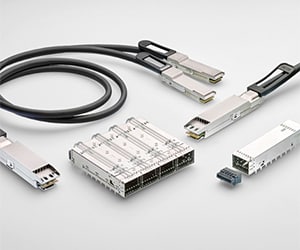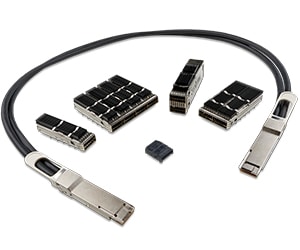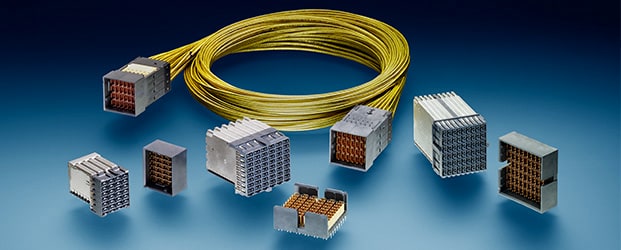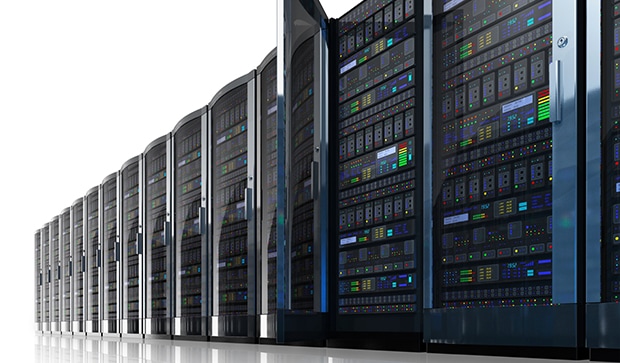
Trend Insight
Increase Speed and Efficiency
Cloud computing and bandwidth-intensive applications have made the data center more important than ever, and managers want to squeeze every last bit of performance out of its architecture, even down to the connector level.
In today’s environment, data centers are gaining importance due to the trend of outsourcing data access through the Cloud, while supporting bandwidth-intensive applications. Data center managers want to squeeze every last bit of performance out of the data center architecture, even down to the connector level. Network equipment manufacturers need to consider five key criteria in choosing input/output (I/O) connectors that maximize speed and efficiency in data centers – flexibility, cost, thermal management, density, and electrical performance. They also must optimize these five criteria in their equipment’s backplane and power connectors.
Flexibility
I/O Connectors
The I/O connector should offer maximum flexibility in the choice of cable type needed for each application. For example, suppose there’s a rack of servers that all connect to a top-of-rack switch. Most of these connections are fairly short – typically three meters or less – so it’s less expensive to use copper cable. But some connections may be longer and require optical cable. By using a pluggable form factor connector such as SFP+, SFP28, QSFP+, or QSFP28, the manufacturer gives the data center operator the ability to choose the right cable to meet specific needs
Data center managers want to squeeze every last bit of performance out of the data center architecture, even down to the connector level.
- Nathan Tracy,
- Technologist, System Architecture
Cost
"Intelligent" Equipment
Based on industry trends, a server’s interconnect might be 1Gbps, but in some of the more demanding applications servers now support 10Gbps or even 40Gbps. The 40Gbps connections have been around for a couple of years, but the latest trend is to go to a 25Gbps solution. The 40Gbps solution implements four lanes of data at 10Gbps each, so the manufacturer can build “intelligent” equipment that can take the data, break it up over four lanes, and then reassemble the stream into 40Gbps. In contrast, 25Gbps uses a single lane, so it has lower overhead and makes for easier implementation in the server and the switch.
Thermal Management
up to 48 Interconnects
When you take a copper cable assembly and replace it with an optical module, the signal is converted from electrical to optical, so the module is now dissipating power. This may be less critical on a server where there are only one or two interconnects, but it’s a significant factor on a switch where there might be up to 48 interconnects. Thermal management becomes critically important because now the equipment has 48 little heaters adding to the heat already generated from internal components.
With optical interconnects, manufacturers need to optimize for a new set of dynamics, and they need optical modules that dissipate less power and I/O connectors that can help to manage that thermal load.
Density
I/O Connectors
On switches, connectors must be as small as possible to provide the highest I/O density while still accommodating optical modules with the above-mentioned thermal loads. Customers desire 24, 48, or even more connections in a 1RU chassis. One way the industry has responded is with the new SFP-DD, OSFP, and QSFP-DD connectors. Industry MSAs (multi-source agreement) have recently defined these new connector standards to enable not only higher density, but also improved thermal management, enabling up to 12 Tbps in a 1RU chassis.


Electrical Performance
Interconnect Channel
Although standards dictate the overall performance of an interconnect channel (loss of host + connector + cable assembly, etc.), connector manufacturers also differentiate their products by delivering enhanced signal integrity performance. For example, a better-performing connector or cable assembly provides more design margin to the equipment designer to enable longer channel reaches or lower-cost PCB materials. Connectors are being shipped today with multiple 25Gbps pairs for 25, 100, and 400Gbps applications, and they are in development or shipping now with 50Gbps pairs as well.
Backplane Connectors
Data Rate
As equipment needs to support higher densities of I/O performance, its backplane also must support the increasing aggregate data rate. With a line card that supports 24 or 48 100-Gigabit ports, a backplane connector with adequate capacity is needed. Equipment manufacturers need next-generation backplane connectors that support 10, 25, 50Gbps, and beyond of bandwidth per differential pair.
In fact, the backplane is the first thing equipment designers think about. They’re going to sell this equipment to large network providers, who want that equipment to last for as many years as possible. If they can design a backplane chassis so it can support a first-generation line card at 10Gbps, and a second-generation line card can plug into the same chassis at 25Gbps, then 50Gbps, then 100Gbps, the same equipment can be retained in that data center for a long time – only the line cards need to be replaced.

STRADA Whisper high speed backplane connectors' revolutionary design transfers data at blinding speeds of 25 Gbps and offers unparalleled scalability up to 56 Gbps—allowing you to achieve efficient future system upgrades without costly backplane or midplane redesigns.
Power Architectures
Connector suppliers
The equipment development engineer is also focused on the power delivery architecture. As discussed, higher bandwidth and higher I/O density lead to higher power requirements. Connector suppliers enable these power architectures with higher-density, lower-loss (voltage drop) power connector systems for bus bar, backplane, or cabled power delivery architectures.
Connectors matter in data center equipment designs. By using the above criteria, network equipment makers can have a significant impact on their products’ efficiency and performance. The newest generation of electrical connectors allows equipment developers to keep up with the challenging demands of our highly connected world.
Author
Nathan Tracy
Nathan Tracy has more than 30 years of experience in technology development, marketing, sales, and business development for TE Connectivity. Currently, he is a technologist on the system architecture team and the manager of industry standards, driving standards activities and working with key customers on new system architectures for the data communications market.
-
www.connectorsupplier.com
Article originally appeared in Connector and Cable Assembly Supplier July 14, 2015.



